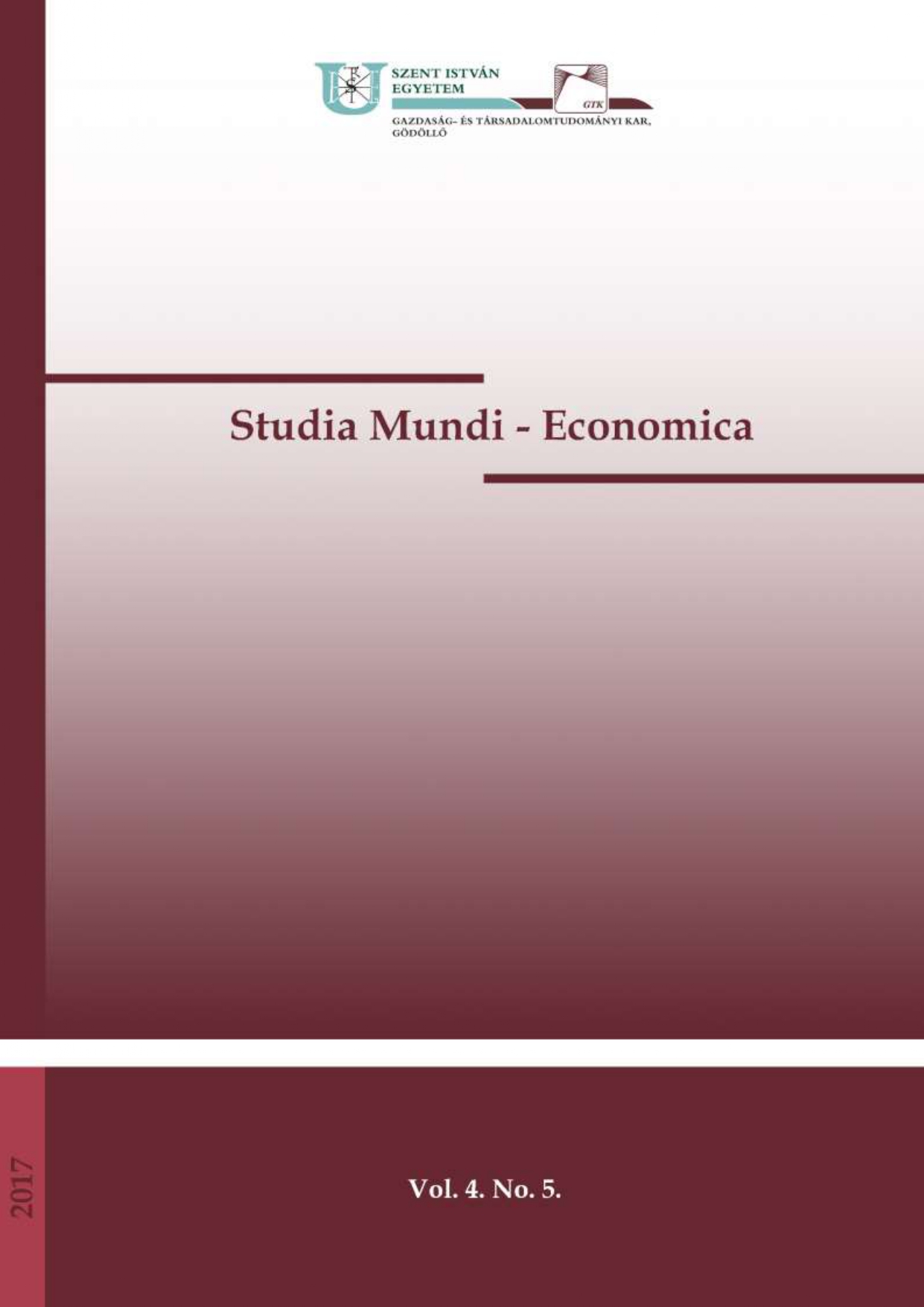Income potential index analysis of hungarian cities and towns
DOI:
https://doi.org/10.18531/Studia.Mundi.2017.04.05.2-11Kulcsszavak:
income, gross value added, subsidy, developmentAbsztrakt
It is crucial to learn which factors could influence the income status of a region. In our study we try to collect basic data which well-represent the chosen topic, and more importantly, which are easy to access and are interpretable on smaller (for example settlement) territorial levels. Based on our hypothesis the received subsidies, the taxes paid by local people and the gross value added generated by local enterprises show strong correlation with the formation of the income status, and this hypothesis was tested for cities and towns in this paper.
Hivatkozások
Annoni P. – Kozovska K. (2010): EU Regional Competitiveness Index 2010. European Commission Joint Research Centre, Publications Office of the European Union, Luxembourg, 28-47.p., Available at: http://publications.jrc.ec.europa.eu/repository/handle/JRC58169. [Downloaded: 2017.03.12.]
Castellis M. (1972): La question urbaine. Transleted by Alan Sheridan in 1977. Edward Amold Ltd., London, 493 pp.
Csath M. (2016): A regionális fejlettség mérése társadalmi-gazdasági mutatók alapján. Pest megyei esettanulmány. In: Csath M. (ed.): Regionális versenyképességi tanulmányok. Budapest, NKE Szolgáltató Nonprofit Kft., 73-107. p.
Enyedi Gy. (1984): Az urbanizációs ciklus és a magyar településhálózat átalakulása, Értekezések-emlékezések. Budapest, Akadémiai Kiadó, 14-19. p.
Enyedi Gy. (2012): Városi világ. Budapest, Akadémiai Kiadó, 186 pp.
European Commission (2015): Regional Policy – Inforegio: Which regions are affected? Available at: http://ec.europa.eu/regional_policy/archive/policy/region/index_en.htm. [Downloaded: 2017.03.12.]
GeoX Kft. (2016): GeoIndex, Települési vásárlóerő 2014. Available at: http://www.geoindex.hu/adatbazisok/telepulesi-vasarloero/. [Downloaded: 2017.03.13.]
Howard E. (1902): Garden cities of To-morrow. London, Swan Sonnenschein & Co., 195 pp.
Huzsvai L. – Vincze Sz. (2012): SPSS-könyv, Seneca Books Kiadó, 325 pp.
Káposzta J. – Nagy A. - Nagy, H. (2014): Efficiency of Hungarian regions in using the development funds for touristic purposes. Regional Economy. South of Russia. Vol. 4. No. 6. 33-39. p.
Káposzta J. – Tóth T. - Singh M K. (2008): Perspectives on regional economic development policy and strategy. Management and Behaviour in Organizations. Vol. 2: Selected Proceedings of the First International Conference on Social Sciences. Izmir, Yasar University, Paper 5. 9 p. (ISBN:978-605-5741-01-3)
Kassai Zs (2017): A közösségi aktivitás jellemzői Heves megye két hátrányos helyzetű településén. Pro Scientia Ruralis. Vol. 2. No. 1. 35-47. p. Available from: http://psr.pahru.ro/images/psr/2017I/PRS-17-1-35-47.pdf. [Downloaded: 2017.02.22.]
Le Corbusier (1986): Towards a New Architecture (Vers une Architecture), Translated from the thirteenth edition and with an Introduction by Frederick Etchells. New York, Dover Publications Inc., 318 pp.
Nagy A. - Virág Á. (2014): Destination management in Hungary. Estnik Apk Stavropolya / Agricultura Bulletin of Stavropol Region. Vol. 1. No. 1., 41-44. p.
Péli L. – Neszmélyi GY. I. (2015): Territorial Differences Of Rural Cities And The Development Of Transport Infrastructure In Hungary. Romanian Review Of Regional Studies: Journal of The Centre For Regional Geography. Vol 11. No. 2. 69-84. p.
Porter M. – Stern S. – Green M. (2015): Social Progress Index 2015. Washington, Social Progress Imperative, 158p., Available at: http://13i8vn49fibl3go3i12f59gh.wpengine.netdna-cdn.com/wp-content/uploads/2016/05/2015-SOCIAL-PROGRESS-INDEX_FINAL.pdf. [Downloaded: 2017.03.10.]
Sassen S. (1991): The Global City: New York, London, Tokyo. New Jersey, Princeton University Press, 22-34. p.
Schuchmann J. – Váradi Zs (2015): A magyar nagyváros-térségek társadalmi- demográfiai szerkezete. In: Szirmai Viktória (ed.): A területi egyenlőtlenségektől a társadalmi jól-lét felé. Székesfehérvár, Kodolányi János Főiskola. 111-130 p.
Stiglitz E. J. – Sen A. – Fitoussi J. (2010): Mismeasuring Our Lives: Why GDP Doesn't Add Up. Report by the Commission on the measurement of Economic Performance and Social Progress, Available at: http://library.bsl.org.au/jspui/bitstream/1/1267/1/Measurement_of_economic_performance_and_social_progress.pdf. [Downloaded: 2017.03.11.]
Szirmai V. (ed) (2011): Urban Sprawl in Europe: Similarities or Differences? Budapest, Aula Kiadó. 280 p.
Tóth R.,(2016): A magyarországi kis- és közepes vállalkozások regionális különbségei. In: Csath M. (ed.): Regionális versenyképességi tanulmányok. Budapest, NKE Szolgáltató Nonprofit Kft., 143-179. p.
Letöltések
Megjelent
Folyóirat szám
Rovat
License
Copyright (c) 2017 Lilla Áldorfainé Czabadai, Zoltán Topa, György Áldorfai

This work is licensed under a Creative Commons Attribution-NonCommercial-NoDerivatives 4.0 International License.
A folyóirat Open Access (Gold). Cikkeire a Creative Commons 4.0 standard licenc alábbi típusa vonatkozik: CC-BY-NC-ND-4.0. Ennek értelmében a mű szabadon másolható, terjeszthető, bemutatható és előadható, azonban nem használható fel kereskedelmi célokra (NC), továbbá nem módosítható és nem készíthető belőle átdolgozás, származékos mű (ND). A licenc alapján a szerző vagy a jogosult által meghatározott módon fel kell tüntetni a szerző nevét és a szerzői mű címét (BY).






